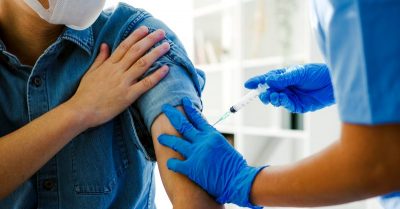Adverse Rare Events to Vaccines for COVID-19: From Hypersensitivity Reactions to Thrombosis and Thrombocytopenia
International Reviews of Immunology

All Global Research articles can be read in 51 languages by activating the “Translate Website” drop down menu on the top banner of our home page (Desktop version).
To receive Global Research’s Daily Newsletter (selected articles), click here.
Visit and follow us on Instagram at @crg_globalresearch.
***
Abstract
Vaccines for the prevention of coronavirus disease 2019 (COVID-19) started to be developed since the initiation of the COVID-19 pandemic. Up to now, four vaccines have been authorized by international agencies such as European Medicines Agency (EMA). Two are DNA vaccines (ChAdOx1 nCov-19 and Ad26.COV2.S) and two mRNA vaccines (BNT162b2 and mRNA-1273). The administration of the vaccines has been associated with a strong decrease in the infections by SARS-CoV-2 and deaths associated with it.
However, in parallel to these results, some rare adverse events have also been described. In that sense, events of thrombosis, thrombocytopenia, and hemorrhage have been described in close temporal proximity to the administration of the DNA vaccines ChAdOx1 nCov-19 and Ad26.COV2.S, but also mRNA vaccines.
Recent scientific reports have been released with updated information on the possible association of thrombotic thrombocytopenia and COVID-19 vaccines. On the other hand, since the initiation of the vaccination campaigns, adverse hypersensitivity reactions have been described after mRNA and DNA vaccines administration for COVID-19. Although globally these adverse events are rare, a high proportion of the world population will be exposed to these vaccines. For that reason, their safety and tolerance should be carefully considered. In this review, we provide an updated review of the last scientific findings that can explain the rare side effects that the vaccines for COVID-19 can produce.
1. Vaccines for COVID-19: DNA and mRNA vaccines
Four vaccines for the prevention of coronavirus disease 2019 (COVID-19) produced by severe acute respiratory syndrome coronavirus 2 (SARS-CoV-2) have been authorized by European Medicines Agency (EMA) so far. Two are mRNA vaccines: BNT162b2 developed by Pfizer-BioNTech and mRNA-1273 developed by Moderna Therapeutics. The other two are DNA vaccines: ChAdOx1 nCov-19 produced by AstraZeneca and Ad26.COV2.S produced by Janssen-Johnson&Johnson. The approvals were based on randomized, blinded, controlled clinical trials [1–3, 52]. Both mRNA vaccines BNT162b2 and mRNA-1273 are based on a mRNA molecule that encodes the viral spike (S) glycoprotein of SARS-CoV-2. The mRNA molecule on these vaccines is surrounded by a lipid nanoparticle (LNP) that provides stability (Figure 1). In order to increase the vaccine efficiency and delivery, the LNP was subjected to a process of PEGylation, that is based on the chemical association of polyethylene glycol (PEG) to the LNP surface. On the other hand, the DNA vaccines ChAdOx1 nCov-19 and Ad26.COV2.S are based on adenovirus vectors (Figure 2). Ad26.COV2.S vaccine contains a replicant deficient human adenovirus type 26 vector and the ChAdOx1 nCov-19 vaccine (also named AZD1222, commercial name: Vaxzevria) is based on the replication-deficient chimpanzee adenovirus vector ChAdOx1 containing the gene that encodes the glycoprotein spike (S) antigen of SARS-CoV-2.


The administration of the vaccines for COVID-19 to the general population has been associated with an important drop in new infections with SARS-CoV-2 and a decrease in deaths due to COVID-19 [4,5]. However, since the initiation of the administration of the vaccines for COVID-19 in December 2020, adverse events have also been described. The mRNA vaccines were the first to be administrated and for those vaccines, some cases of adverse hypersensitivity reactions were reported [6]. The DNA vaccine ChAdOx1 nCov-19 was also involved in hypersensitivity reactions, and it has been recently linked, together to the other DNA vaccine Ad26.COV2.S, to rare thrombotic events. Cases of thrombotic events have also been described in close temporal proximity with the administration of mRNA vaccines. In this review, we summarize the current knowledge regarding the safety of the currently available vaccines for COVID-19 with special attention to the last scientific advancements made on the adverse events that these vaccines might induce.
2. Thrombotic thrombocytopenia after administration of vaccines for COVID-19
Recent adverse events involving thrombocytopenia, thrombosis, and hemorrhage, that include a few cases of deaths, in temporal proximity to the administration of ChAdOx1 nCov-19 vaccine, promoted the temporary suspension of the administration of the vaccine by different European countries on March 15, 2021, and a reevaluation of the vaccine safety by EMA [7]. EMA concluded that although the causal link of very rare events of thrombosis and ChAdOx1 nCov-19 vaccine has not been proven, the connection cannot be excluded. Consequently, the safety information of the vaccine was updated including the warning on the rare events of thrombotic thrombocytopenia as a potential rare side effect. EMA highlighted that the benefits of the ChAdOx1 nCov-19 vaccine continue to outweigh the risks. However, the agency advised that the scientific bases of the potential side effects require investigation [8]. Cases of thrombosis in close temporary proximity to the administration of the vaccine Ad26.COV2.S have also been recently reported in the USA [9–11], which prompted FDA to halt the administration of the vaccine and to stop its distribution in Europe in order to perform a reevaluation of the possible side effects linked with the cases of thrombosis. Recent scientific reports have deepened onto the possible link of the adverse events of thrombotic thrombocytopenia and COVID-19 vaccines [10,12,13].
Click here to read the full article.
*
Note to readers: Please click the share buttons above or below. Follow us on Instagram, @crg_globalresearch. Forward this article to your email lists. Crosspost on your blog site, internet forums. etc.
Featured image is from Children’s Health Defense

